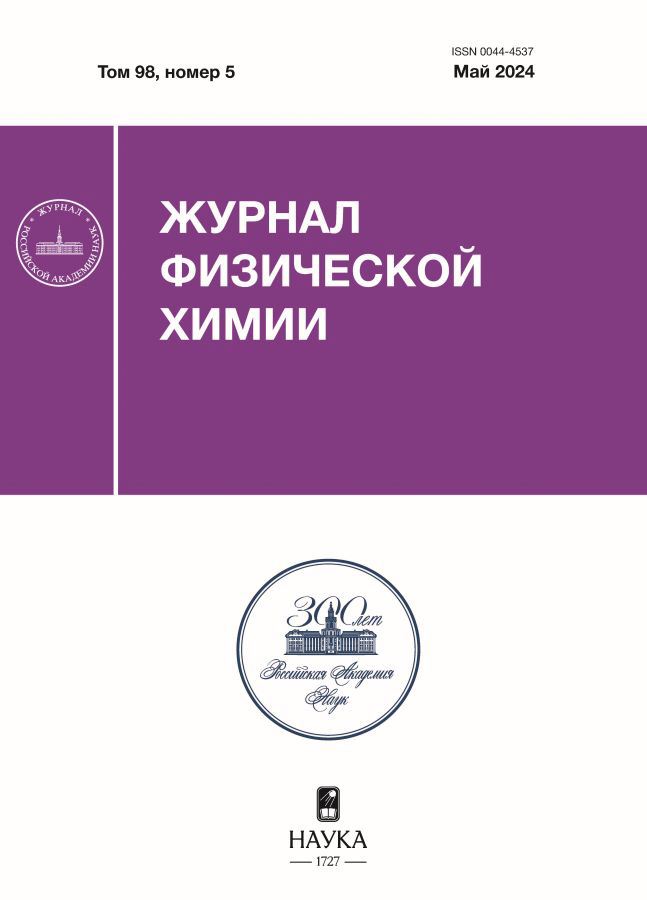Асимптотическое поведение ридберговских состояний молекулярного водорода в пределе объединенного атома
- Авторлар: Лихарев А.С.1, Пазюк Е.А.1, Столяров А.В.1
-
Мекемелер:
- Московский государственный университет имени М. В. Ломоносова
- Шығарылым: Том 98, № 5 (2024)
- Беттер: 63-69
- Бөлім: ТЕОРЕТИЧЕСКАЯ СПЕКТРОСКОПИЯ
- ##submission.dateSubmitted##: 27.02.2025
- ##submission.datePublished##: 29.12.2024
- URL: https://freezetech.ru/0044-4537/article/view/668984
- DOI: https://doi.org/10.31857/S0044453724050086
- EDN: https://elibrary.ru/PJXEWA
- ID: 668984
Дәйексөз келтіру
Аннотация
В рамках одноканальной теории квантового дефекта и аналитической модели остовно-поляризационного потенциала исследовано асимптотическое поведение борн-оппенгеймеровских (БО) потенциальных кривых возбужденных электронных состояний молекулярного водорода на малых и средних межъядерных расстояниях R. Показано, что электронные состояния молекулы H2, обладающие gerade и ungerade симметрией, гладко сходятся в пределе объединенного атома к синглетным и триплетным состояниям гипотетического атома гелия 2He I(1,3L), находящегося в S, D, G,… и P, F, H,… состояниях, соответственно. Проведено однозначное отнесение рассматриваемых молекулярных состояний по главному квантовому числу n и угловому моменту ридберговского электрона l, как на диссоциационном пределе H(1s) +H(nl), так при R->0. Из анализа формы построенных функций квантового дефекта μlΛ(R) и степени гладкости их первой производной по R удалось установить места некорректного отнесения БО-энергий, полученных в рамках прецизионных ab initio расчетов для состояний с высоким значением l.
Толық мәтін
Авторлар туралы
А. Лихарев
Московский государственный университет имени М. В. Ломоносова
Хат алмасуға жауапты Автор.
Email: a_lixarev@mail.ru
Химический факультет
Ресей, МоскваЕ. Пазюк
Московский государственный университет имени М. В. Ломоносова
Email: a_lixarev@mail.ru
Химический факультет
Ресей, МоскваА. Столяров
Московский государственный университет имени М. В. Ломоносова
Email: a_lixarev@mail.ru
Химический факультет
Ресей, МоскваӘдебиет тізімі
- Столяров А.В. // Вклад академической науки в развитие космической отрасли. М.: РАН, 2022. С. 369.
- Вибе Д.З., Столяров А.В. // Земля и Вселенная. 2021. Т. 2. С. 19.
- Мурга М.С., Вибе Д.З., Васюнин А.И. и др. // Успехи химии. 2020. Т. 89. № 4. С. 430.
- Meshkov V.V., Stolyarov A.V., Ivanchik A.V., Varshalovich D.A. // JETP Letters. 2006. V. 83(8) P. 303.
- Sharp T.E. // Atomic Data. 1971. V. 2. P. 119.
- Seaton M.J. // Rep. Prog. Phys. 1983. V. 46, № 2. P. 167–257.
- Greene C.H., Jungen Ch. // Adv. At. Mol. Phys. 1985. V. 21. P. 51.
- Lefebvre-Brion H., Field R.W.. The Spectra and Dynamics of Diatomic Molecules: Revised and Enlarged Edition // Academic Press, 2004.
- Bunker P.R. // J. Mol. Spectroscopy. 1972. V. 5. P. 478–494.
- Kolos W., Wolniewicz L. // Rev. Mod. Phys. 1963. V. 35. № 3. P. 473.
- Arcuni P.W., Hessels E.A., Lundeen S.R // Phys. Rev. A. 1990. V. 41. № 7. P. 3648.
- Пазюк Е.А., Пупышев В.И., Зайцевский А.В., Столяров А.В. //Журн. физ. химии. 2019. T. 93. C. 1461.
- Зар Р. Теория углового момента М.: МИР, 1993. 351 с.
- Jensen P. Bunker P.R. Computational Molecular Spectroscopy. N.Y.: 2000. 370 p.
- Jungen Ch. Molecular Applications of Quantum Defect Theory.U.S.: Institute of Physics Publishing, Bristol and Philadelphia, 1996. 654 p.
- Child M.S. Theory of Molecular Rydberg States. Cambridge University Press, 2011.
- Stolyarov A.V., Pupyshev V.I., Child M.S. // J. Phys. B. 1997. V. 30(14). P. 3077.
- Stolyarov A.V., Child M.S. // J. Phys. B. 1999. V. 32(2) P. 527.
- Stolyarov A.V., Child M.S. // Phys. Rev. A. 2001. V. 63(5). P. 052510.
- Kiyoshima T., Sato S., Pazyuk E.A. et al. // J. Chem. Phys. 2003. V. 118(1). P. 121.
- Pachucki K. // Phys. Rev. A. 2010. V. 82. P. 032509.
- Pachucki K., Komasa J. // Ibid. 2011. V. 83. P. 042510.
- Silkowski M., Zientkiewicz M., Pachucki K. // Adv. Quant. Chem. 2021. V. 83.
- Silkowski M., Pachucki K. // Mol. Phys. 2022. V. 120(19–20). P. e2062471.
- Mulliken R.S. // J. Am. Chem. Soc. 1964. V. 86(16). P. 3183.
- Dabrowski I., Tokaryk D.W., Lipson R.H., Watson J.K.G. // J. Mol. Spectrosc. 1998. V. 189(1) P. 110.
- Bishop D.M., Wetmore R.W. // Mol. Phys. 1973. V. 26(1). P. 145.
- Zon B.A. // Sov. Phys. JETP. 1992. V. 75. P. 19.
- Watson J.K.G. // Mol. Phys. 1994. V. 81(2). P. 277.
- Bishop D.M., Cheung L.M. // J. Phys. B. 1978. V. 11. P. 3133.
- Bishop D.M., Lam B. // Mol. Phys. 1988. V. 65(3). P. 679
- NIST atomic data; https://www.nist.gov/pml/atomic-spectra-database.
- Muhyedeen B.R. J. // Euro. J. Sci. Res. 2017. P. 357.
Қосымша файлдар














